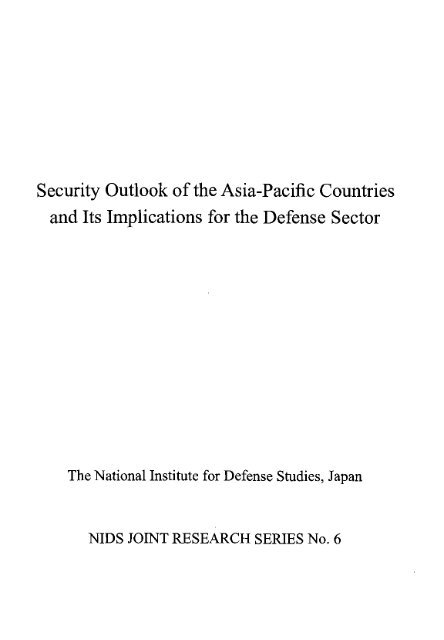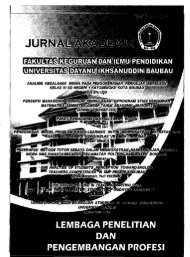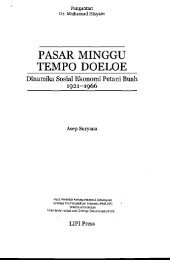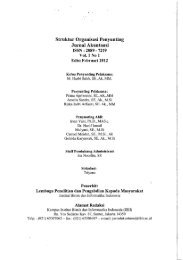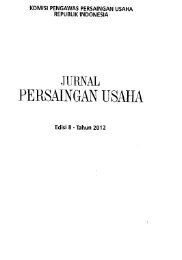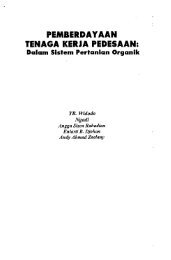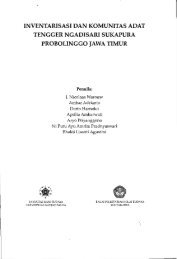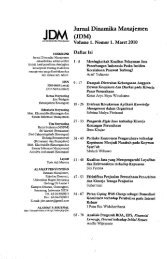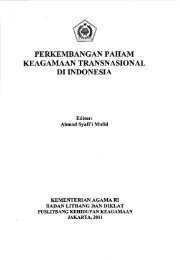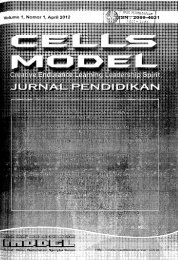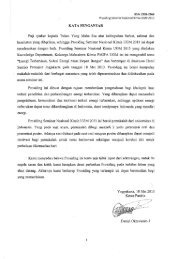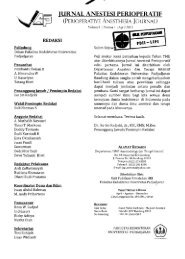Security Outlook of the Asia-Pacific Countries and Its ... - PDII â LIPI
Security Outlook of the Asia-Pacific Countries and Its ... - PDII â LIPI
Security Outlook of the Asia-Pacific Countries and Its ... - PDII â LIPI
You also want an ePaper? Increase the reach of your titles
YUMPU automatically turns print PDFs into web optimized ePapers that Google loves.
<strong>Security</strong> <strong>Outlook</strong> <strong>of</strong> <strong>the</strong> <strong>Asia</strong>-<strong>Pacific</strong> <strong>Countries</strong><br />
<strong>and</strong> <strong>Its</strong> Implications for <strong>the</strong> Defense Sector<br />
,<br />
Contents<br />
Preface<br />
Eiiehl Katahara<br />
1<br />
CHAPTER 1<br />
3<br />
Indonesia: <strong>Security</strong> <strong>Outlook</strong>, Defense Policy, <strong>and</strong> Regional Cooperation<br />
RlzalSUKMA<br />
Introduction. .. . 3<br />
Indonesia's <strong>Security</strong> Challenges ," 4<br />
Developments in Defense Sector: Extensive Needs, Modest Improvement 10<br />
External Cooperation<br />
15<br />
Conclusion<br />
'.. 17<br />
CHAPTER 2 }t~ 19<br />
Malaysia's Strategic <strong>Outlook</strong> <strong>and</strong> Developments in it~ Defence Policy<br />
TANG Siew Mun . ~ )<br />
Malaysia's Strategic <strong>Outlook</strong><br />
19<br />
The Region's "Hot Spots"<br />
20<br />
Putting A Number On Defence................................................................. .. 23<br />
More Woes for <strong>the</strong> Military in <strong>the</strong> Wake <strong>of</strong> Economic Downturn . 24<br />
A New Mission for <strong>the</strong> Malaysian Armed Forces?<br />
24<br />
Defence Diplomacy<br />
25<br />
Diseonnect Between Policy <strong>and</strong> Practice: Deterrence <strong>and</strong> Forward Defence 25<br />
Looking Ahead for Malaysia's Defence Poliey<br />
27<br />
CHAPTER 3<br />
The Continuing Malaise <strong>of</strong> National <strong>Security</strong> in <strong>the</strong> Philippines<br />
Herman Joseph S. KRAFT<br />
Meeting <strong>the</strong> Challenges<br />
29<br />
State <strong>of</strong><strong>the</strong> Armed Forces <strong>of</strong> <strong>the</strong> Philippines<br />
35<br />
<strong>Security</strong> Relationships.. . 37<br />
Bibliography<br />
38<br />
29
p-<br />
CHAPTER 4<br />
Singapore in 2010: Innovation <strong>and</strong> Confidence amidst Strategic<br />
Uncertainty<br />
LAMPengEr<br />
41<br />
Power shift in <strong>Asia</strong> <strong>and</strong> <strong>the</strong> World<br />
41<br />
ASEAN-Centered Regional Architecture , 42<br />
Diplomacy <strong>and</strong> Cooperation: Immediate Neighbors<br />
43<br />
SAF Abroad: Gulf<strong>of</strong>Aden<br />
44<br />
SAF Abroad: Afghanistan<br />
45<br />
SAF Abroad: Training as an Advanced Networked Force<br />
45<br />
Singapore's Defense Research <strong>and</strong> Development<br />
48<br />
Epilogue<br />
50<br />
CHAPTER 5<br />
51<br />
Years <strong>of</strong> Living Dangerously: Thail<strong>and</strong>'s Current <strong>Security</strong> Challenges<br />
Pavin Chachavalpongpun<br />
Violent Political Conflicts :?~,:~ 52<br />
Insurgency in <strong>the</strong> Deep South " , 54<br />
Territorial Disputes with Cambodia ~ ( 55<br />
Threats from Myanmar<br />
56<br />
Non-Traditional Threats<br />
58<br />
Impact on Defence Policy<br />
60<br />
CHAPTER 6<br />
Myanmar's Post-Election <strong>Security</strong> Challenges<br />
Tin Maung Maung Than<br />
Elections in 2010: Redistribution <strong>of</strong> Power<br />
The Role <strong>of</strong> Defence Services in Post-Election Myanmar<br />
<strong>Security</strong> Challenges<br />
Conclusion<br />
63<br />
63<br />
67<br />
74<br />
80<br />
CHAPTER?<br />
The U.S. Secnrity <strong>Outlook</strong> in <strong>the</strong> <strong>Asia</strong>-<strong>Pacific</strong> Region<br />
Andrew S. Erickson<br />
Key Future Trends & Approaches<br />
<strong>Asia</strong>-Paeific Applications<br />
Conclusion<br />
81<br />
82<br />
91<br />
117
CHAPTERS<br />
Meeting <strong>the</strong> Challenge <strong>of</strong><strong>Asia</strong>'s Changing <strong>Security</strong> Environment:<br />
China's Response to <strong>the</strong> New Threats<br />
You}i<br />
Challenge Number One: Coordinated Efforts against China's Rise<br />
Strategic Challenge Number Two: Avoiding Simultaneous Multiple Armed<br />
Conflicts<br />
Strategic Challenge Number Three: A Second Korean War on <strong>the</strong> Brink<br />
Conelusion<br />
123<br />
124<br />
135<br />
140<br />
146<br />
CHAPTER 9<br />
149<br />
Japan's <strong>Security</strong> <strong>Outlook</strong>: <strong>Security</strong> Challenges <strong>and</strong> <strong>the</strong> New National<br />
Defense Program Guidelines<br />
Tomotaka SHOJI<br />
Introduction<br />
149<br />
<strong>Security</strong> ChEll,lenges Facing Japan: Emer.gen~e <strong>of</strong> <strong>the</strong> "ChiJ~r.£hallenge"'" 150<br />
The New NEltlOnal Defense Program GUidelInes :~.\, 155<br />
Multilateralism <strong>and</strong> Implications for <strong>Security</strong> in Sou<strong>the</strong>ast A\9i
Preface<br />
This report is based on presentations <strong>of</strong><strong>the</strong> second "International Workshop on <strong>Asia</strong><br />
<strong>Pacific</strong> <strong>Security</strong>" hosted by <strong>the</strong> National Institute for Defense Studies (NIDS). This<br />
workshop was held on January 27-28, 2011, with distinguished experts invited from<br />
various countries in <strong>the</strong> <strong>Asia</strong>-<strong>Pacific</strong> region, <strong>and</strong> <strong>the</strong> report is published as part <strong>of</strong> <strong>the</strong><br />
"NIDS Joint Research Series".<br />
The <strong>the</strong>me <strong>of</strong><strong>the</strong> workshop was "<strong>Security</strong> <strong>Outlook</strong> <strong>of</strong><strong>the</strong> <strong>Asia</strong>-<strong>Pacific</strong> <strong>Countries</strong> <strong>and</strong><br />
<strong>Its</strong> Implications for <strong>the</strong> Defense Sector". Each participant presented a perspective on<br />
his or her assigned country's security outlook, including significant security<br />
challenges <strong>and</strong> <strong>the</strong>ir implications for <strong>the</strong> country's defense policy, force structure <strong>and</strong><br />
defense procurement, <strong>and</strong> future prospects for regional security cooperation.<br />
7;f><br />
In <strong>the</strong> <strong>Asia</strong>-<strong>Pacific</strong> region, <strong>the</strong>re has been progress in buildin'g"regional frameworks<br />
such as <strong>the</strong> <strong>Asia</strong> <strong>Pacific</strong> Eeonomic Cooperation (APEC), ASEAN Regional Forum<br />
(ARP), East<strong>Asia</strong> Summit (EAS), <strong>and</strong> ASEAN Defense Ministers' Meeting (ADMM)<br />
Plus. However, unlike Europe, this region laeks overarching security architecture.<br />
Traditional security issues remain in <strong>the</strong> region, while non-traditional security issues<br />
like terrorism, natural disaster, <strong>and</strong> p<strong>and</strong>emic are also looming large on <strong>the</strong> region's<br />
security agenda. We hope that this report will contribute to sharing our knowledge<br />
about major security issues facing <strong>the</strong> region, <strong>and</strong> deepening mutual underst<strong>and</strong>ing<br />
<strong>and</strong> cooperation between Japan <strong>and</strong> <strong>Asia</strong>-<strong>Pacific</strong> countries.<br />
The authors <strong>of</strong>chapters are Dr. Rizal Sukma, Dr. Tang Siew Mun, Dr. Hennan Joseph<br />
S. Kraft, Dr. Lam Peng Er, Dr. Pavin Chachavalpongpun, Dr. Tin Maung Maung<br />
Than, Dr. Andrew S. Erickson, Dr. You Ji, <strong>and</strong> Dr. Tomotaka Shoji. The views<br />
expressed herein are those <strong>of</strong> <strong>the</strong> authors <strong>and</strong> do not necessarily reflect <strong>the</strong> views <strong>of</strong><br />
NlDS or any institutes with whieh <strong>the</strong>y are affiliated.
We would like to thank <strong>the</strong> authors for <strong>the</strong>ir valuable contributions <strong>and</strong> o<strong>the</strong>r<br />
participants in <strong>the</strong> workshop.<br />
n<br />
I II<br />
1 .1<br />
1 'I<br />
,<br />
,<br />
j 'I<br />
December 2011<br />
Eiichi Katahara<br />
Director, Regional Studies Department<br />
'I{!><br />
",<br />
vi


